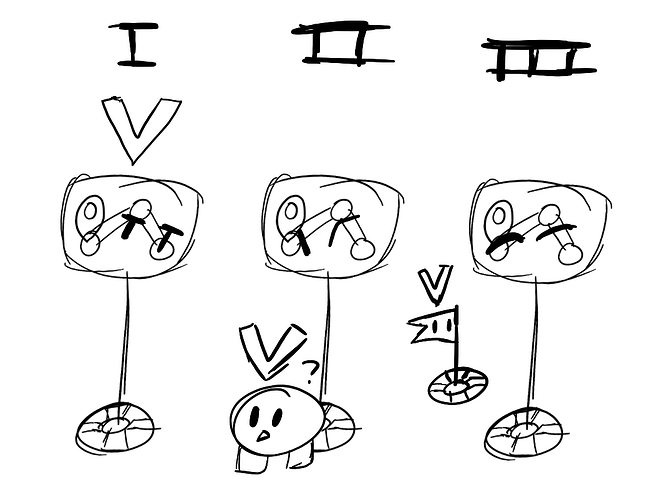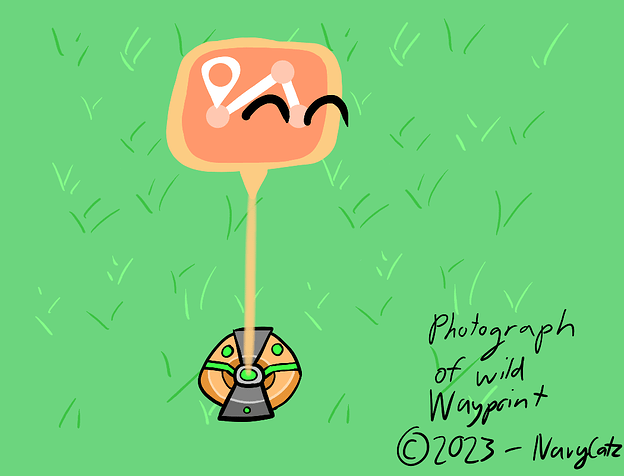Appearance
Waypoints are in the Naranja genus of the Herramienta Family. As such, they are orange devices, with a head connected to the main body by a light beam, or a “neck”. The head of all Naranja devices shows something about what they do: in this case, the waypoint’s head shows a marker. The base has three blue dot lights, one on the front, and two on the top, and two lines of light, located on either side of the light neck. On game start, they, like most devices, become invisible. However, their special characteristic, their arrow organ, can become visible in game. Waypoints are on the heavier side of devices, taking up 175 memory each. However, there can only be up to 64 waypoints on a world at a time.
Main Use
Waypoints are mainly used to highlight locations with their arrow organ. All waypoints only have one arrow organ. This organ can move completely independent to the main waypoint, and emits a light that is only able to be seen by Gims. However, waypoints have a large degree of control over where they can put their arrow. Waypoints also cannot start a wire vine, instead, they always end one.
Differences in the Population
Waypoints have a medium about of possible genetic variety for a device, allowing them to do a variety of different things in their species.
- The Waypoint’s Target
- This is the main difference between waypoints, allowing them to choose what they want to highlight with their arrow.
1a. Self-marking. These waypoints like attention, and they place their waypoint on themselves to draw attention to themselves.
1b. Gim-marking. These waypoints are tricky, and like to play tricks on both types of Gims, Creative and In-game. Keep an extra eye on these ones!
1c. Flag-marking. These waypoints help the miniscule flags get more attention, unwanted or otherwise.
1d. Ball-marking. A new species of waypoint recently evolved out of the flag-marking waypoints to track the ball, due to how fun the ball is to use.
-
Name. Waypoints can change their name, and their arrow will display that name wherever it goes.
-
Deactivate when Gim in range. Waypoints can be quite shy, and can choose to turn off their arrows when a Gim gets close to their arrow, allowing for extra chaos!
-
Active on Game Start. Waypoints can choose to hide their arrow from all Gims at the start of the game, and turn them off later.
-
Activate/Deactivate on channel. Waypoints can also choose to turn their arrow on or off if they hear a message on a channel.
-
Scope. Waypoints can also only hide their arrow to certain Gims.
-
Color. Waypoints recently evolved to have variable coloration.
Interactions with other Devices
Waypoints, due to their playful nature, create complex interactions with other devices that can cause unintended side effects. A running list of any mentionable device interactions can be found below.
Trigger-Relay-Waypoint (Player Tracking):
This is the most infamous combo, which has confused many a Gim. Most of the confusion comes from waypoints only having one arrow, causing them to have to choose which players to highlight.
-
All players:
-
All other players:
-
All players on my team:
-
Random player:
- As far as I can tell, this works exactly as intended. When the trigger is triggered, the waypoint picks a random player to put the arrow on.
-
All players on specific team:
-
Random player on specific team:
-
Single player on each team:
The Golden Rule of Waypoints
The final section is to help novice Gims with not seeing issues with waypoint arrows, and coming to the wrong conclusion. It was stated earlier in the guide, but repetition is helpful when learning! The golden rule of waypoints is as follows:
One entitiy per arrow.
A waypoint can only put their arrow on one entity at a time, whether it is themselves, a flag, or a Gim. This can cause issues down the road, but the innovation that can be made becuase of it is genius.
To conclude, waypoints are playful, heavy, devices of the Naranja genus. They interact with the other devices more than most devices, which can confuse many a Gim. However, with proper study and patience, they can behave as well as a trigger!
Have fun building,
-ClicCliac, Beanine, and TriggerTock.
Photos generously provided from the @NavyCatZ foundation.



